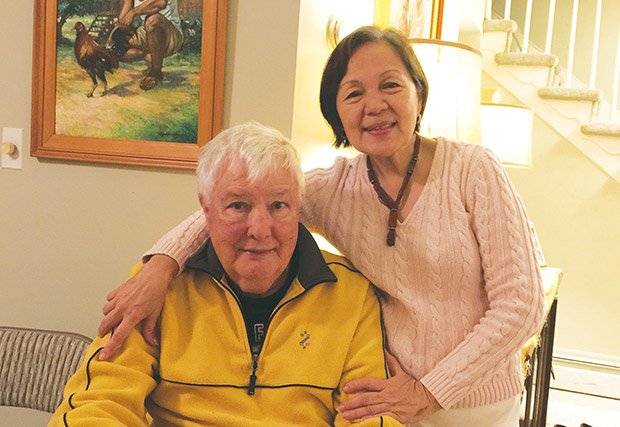On November 16, 2015, Teresa Taylor’s husband, Jim, was reading in his home office. When she checked on him, she knew something was wrong. “His face was twitching, his speech was slurred, his head was drooping and his arms were just hanging down,” says Teresa. “He had all the symptoms of a stroke.”
Teresa called 9-1-1 and paramedics took Jim to the Center for Trauma and Critical Care at the George Washington University Hospital. “Luckily, Teresa knew the signs of a stroke,” says Kathleen Burger, DO, Neurologist and Director of the Stroke Center at GW Hospital. “Jim was given tPA, a clot-dissolving medication and had a slight improvement,” says Dr. Burger. “We injected dye into his arteries, found the clot, and extracted it. After the procedure, Jim was able to talk, raise his arms and walk, with no residual damage.”
While doctors were evaluating Jim, they also discovered a narrowing of his carotid artery. Wayne J. Olan, MD, Director of Minimally Invasive Neurosurgery, treated Jim in the ER. “Jim’s right cerebral artery was narrowed, so we scheduled him to come back for a stent procedure,” says Dr. Olan. “By placing the stent, we prevented another stroke from occurring.”
Stroke treatment crucial within first three hours
Neurosurgeon and Interventional Neuroradiologist Dimitri Sigounas, MD, says receiving treatment within three hours of onset of stroke symptoms is crucial. “If there is a clot in the brain, there is no backup blood flow supply. After about six hours without circulation, the success of surgical intervention is cut dramatically,” says Dr. Sigounas.
Dr. Olan explains that since the hospital received designation as a Comprehensive Stroke Center (CSC), their patient volume has increased, and so has community awareness. “We’re the CSC closest to the White House, and we’ve become known as the place to go.
Our outcomes have been spectacular,” says Dr. Olan. The goal is to have treatment initiated within 30 minutes of the patient getting to the hospital. “The first responders, our ER, the floor nurses, ICU and radiology – are all on board to make this happen,” says Dr. Olan.
Dr. Sigounas says they are notified when a stroke patient is coming in. “It’s incredibly responsive and impressive to watch,” says Dr. Sigounas. “I live close by, so if I am on call, I can get to the hospital within minutes of an emergency.”
Teresa says this was their first time at GW Hospital. “Jim is retired from the Navy, so he usually goes to Walter Reed Medical Center. But GW Hospital was the closest trauma center to us,” says Teresa. She was glad to see posters in the hallways about signs of stroke. “It’s good to remind people about that,” she says. “I’m glad I knew the signs of stroke – that and GW Hospital helped to save my husband’s life!”
Learn more about the GW Comprehensive Stroke Center

